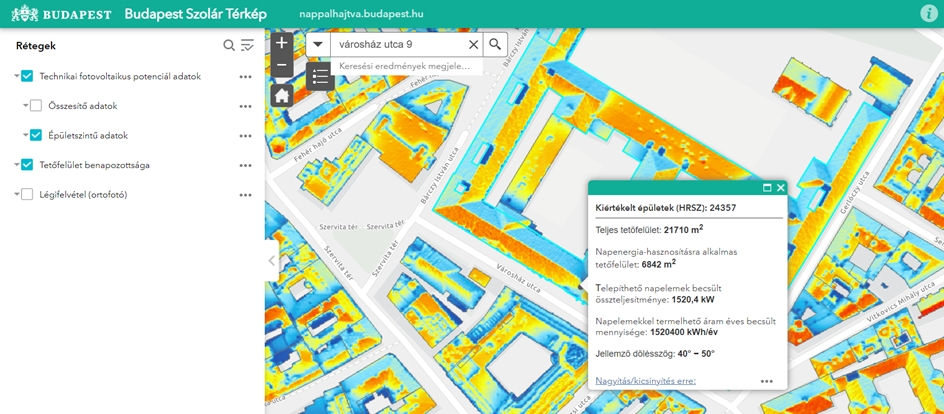The Budapest City Council plans to increase current solar capacity 130 times by 2030 to meet the climate targets set in the Budapest Climate Strategy (40% reduction in the capital’s carbon dioxide emissions by 2030). The target is to install a total of 1,500 MW of solar panels, which means a total of around 10 million square metres of solar panel surface, i.e. at least five square metres of solar panels per inhabitant. With this ambitious plan, we would save nearly 500,000 t of CO2 emissions, i.e. the equivalent of the amount of electricity used by all Budapest residents in one year. The solar programme would reduce Budapest’s total CO2 emissions by 8%, which is one fifth of the total emissions reductions the city government wants to achieve.
The legal, technical and financial possibilities for scaling up solar panels are being identified by the City of Budapest as part of a major technical programme, for which the German government agency EUKI[i] has provided more than half a million euros in financial support.
The “Budapest- Solar Powered” project of the Municipality of Budapest has reached a milestone in September 2022: through significant GIS based developments, the first solar potential map of Hungary, the Budapest Solar Map has been completed. Budapest has now joined the other European cities (e.g. Vienna, Amsterdam, Helsinki, Berlin) that are using interactive solar maps to help residents and other stakeholders planning their solar developments. The “Budapest Solar Map“, developed in cooperation with the Budapest Municipality and the Hungarian Solar Energy Association, is an online application that can be run on mobile phones, which provides information to the capital’s residents and businesses in commerce and industry, about each building of Budapest how much of the roof is suitable for solar energy, what capacity of solar panels can be installed and how much electricity can be generated by solar panels.
The development of the spatial database for the Budapest Solar Map started in 2021, followed by several months of data preparation and the development of a methodology optimised for local conditions and project opportunities. Among the many components of the database are a map layer containing the sites of 344,000 buildings in the capital and a digital surface model covering the entire city and generated by an active remote sensing technique (generated by LiDAR technology).
Based on a simulation of the year-round irradiation of roofs, the solar map shows irradiation data by building, using a clear colour scale.
According to the results of the simulations, the roofs of the capital city have a total solar potential of about 5000 MW. For comparison:
– the Paks Nuclear Power Plant has a capacity of 2000 MW
– Budapest currently has approximately 100 MW of solar panels
– At national level, about 3400 MW of solar capacity has been connected to the electricity grid so far
[i] This project is part of the European Climate Initiative (EUKI). EUKI is a project financing instrument by the German Federal Ministry for Economic Affairs and Climate Action (BMWK). The EUKI competition for project ideas is implemented by the Deutsche Gesellschaft für Internationale Zusammenarbeit (GIZ) GmbH. It is the overarching goal of the EUKI to foster climate cooperation within the European Union (EU) in order to mitigate greenhouse gas emissions.’
Credits for Image: https://nappalhajtva.budapest.hu/szolar-terkep/
